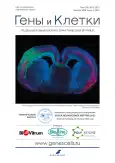Исследование синаптической пластичности в гиппокампе мутантной линии мышей, предрасположенных к эпилептиформной активности
- Авторы: Федулина А.А.1, Матвеева М.В.1, Мальцева К.Е.1, Лебедева А.В.1, Тарабыкин В.С.2
-
Учреждения:
- Национальный исследовательский Нижегородский государственный университет им. Н.И. Лобачевского
- Институт клеточной биологии и нейробиологии клиники Шарите
- Выпуск: Том 18, № 4 (2023)
- Страницы: 462-464
- Раздел: Материалы конференции
- URL: https://journal-vniispk.ru/2313-1829/article/view/256244
- DOI: https://doi.org/10.17816/gc623290
- ID: 256244
Цитировать
Аннотация
В настоящее время практически завершена расшифровка генетического кода человека, а различные генетические мутации вызывают большой интерес у учёных в этой сфере. Исследуются мутации, которые ответственны за проявление заболеваний, а также обусловливают генетическую предрасположенность к ним. Изучение новых механизмов проявления заболеваний является современным, уникальным подходом, способствующим в дальнейшем развитию методов лечения и коррекции многих нейродегенеративных заболеваний у человека. Эпилепсия является одной из распространённых форм неврологической патологии. Понимание сложных механизмов, лежащих в основе эпилептогенеза и генерации приступов при эпилепсии височной доли и других формах эпилепсии, не может быть полностью получено в клинических исследованиях с людьми. В результате использование соответствующих моделей животных имеет важное значение.
Цель работы. Исследование синаптической передачи и долговременной пластичности гиппокампа у мутантной линии мышей, условно названной S5-1, с эпилептиформной активностью. Объектом исследования стала мутантная линия мышей S5-1, имеющая склонность к формированию эпилептиформной активности после индукции ENU-мутагенеза в молекуле ДНК. Для изучения активности in vitro используется метод регистрации локальных полевых потенциалов (local field potential, LFP) на переживающих срезах мозга, совмещающий электрофизиологические и оптические методы.
Для оценки долговременной синаптической пластичности были выбраны два варианта протокола: в первом подавались малые амплитуды стимуляции (50 мА), во втором — большие (500 мА). В первом случае наблюдались высокие показатели долговременной потенциации у группы с эпилептиформной активностью. Потенциация у животных с фенотипом составляла 150–170% от средних значений скорости нарастания ответа до четырёхразрядной стимуляции, когда значения у контрольной группы достигали лишь 120–125%. Данные результаты показывают, что у группы животных с эпилептиформным фенотипом происходит гиперактивация нервных волокон, что является одним из механизмов, лежащих в основе эпилептогенеза. Во втором же случае при подаче больших амплитуд стимуляции было показано достоверное снижение синаптической передачи у животных с эпилептиформной поведенческой активностью (120–150%) по сравнению с контрольной группой (200–250%). Достоверное снижение долговременной синаптической пластичности у животных с эпилептиформной активностью относительно контрольной группы на больших «стрессовых» амплитудах стимуляции может свидетельствовать о нарушении синаптической передачи на молекулярном и клеточном уровнях, что может приводить к ухудшению памяти или снижению когнитивных навыков у мутантных животных, проявляющих признаки эпилепсии.
Из всего вышесказанного можно сделать вывод, что возможный механизм изменения синаптической передачи в гиппокампе мутантной линии мышей S5-1 заключается в том, что после воздействия мутагена и возникновения точечных мутаций развивается ряд патологий, одной из которых является нарушение цитоархитектуры коры головного мозга, которое ведёт к опосредованному изменению в подкорковых структурах, в частности в гиппокампе, и развитию аудиогенных судорог. Вследствие этого возникают нарушения в синаптической передаче и пластичности, что может приводить к снижению памяти и другим когнитивным дисфункциям. Однако предложенный нами возможный механизм развития нарушений в мозге у мутантных животных требует дальнейших исследований.
Ключевые слова
Полный текст
В настоящее время практически завершена расшифровка генетического кода человека, а различные генетические мутации вызывают большой интерес у учёных в этой сфере. Исследуются мутации, которые ответственны за проявление заболеваний, а также обусловливают генетическую предрасположенность к ним. Изучение новых механизмов проявления заболеваний является современным, уникальным подходом, способствующим в дальнейшем развитию методов лечения и коррекции многих нейродегенеративных заболеваний у человека. Эпилепсия является одной из распространённых форм неврологической патологии. Понимание сложных механизмов, лежащих в основе эпилептогенеза и генерации приступов при эпилепсии височной доли и других формах эпилепсии, не может быть полностью получено в клинических исследованиях с людьми. В результате использование соответствующих моделей животных имеет важное значение.
Цель работы. Исследование синаптической передачи и долговременной пластичности гиппокампа у мутантной линии мышей, условно названной S5-1, с эпилептиформной активностью. Объектом исследования стала мутантная линия мышей S5-1, имеющая склонность к формированию эпилептиформной активности после индукции ENU-мутагенеза в молекуле ДНК. Для изучения активности in vitro используется метод регистрации локальных полевых потенциалов (local field potential, LFP) на переживающих срезах мозга, совмещающий электрофизиологические и оптические методы.
Для оценки долговременной синаптической пластичности были выбраны два варианта протокола: в первом подавались малые амплитуды стимуляции (50 мА), во втором — большие (500 мА). В первом случае наблюдались высокие показатели долговременной потенциации у группы с эпилептиформной активностью. Потенциация у животных с фенотипом составляла 150–170% от средних значений скорости нарастания ответа до четырёхразрядной стимуляции, когда значения у контрольной группы достигали лишь 120–125%. Данные результаты показывают, что у группы животных с эпилептиформным фенотипом происходит гиперактивация нервных волокон, что является одним из механизмов, лежащих в основе эпилептогенеза. Во втором же случае при подаче больших амплитуд стимуляции было показано достоверное снижение синаптической передачи у животных с эпилептиформной поведенческой активностью (120–150%) по сравнению с контрольной группой (200–250%). Достоверное снижение долговременной синаптической пластичности у животных с эпилептиформной активностью относительно контрольной группы на больших «стрессовых» амплитудах стимуляции может свидетельствовать о нарушении синаптической передачи на молекулярном и клеточном уровнях, что может приводить к ухудшению памяти или снижению когнитивных навыков у мутантных животных, проявляющих признаки эпилепсии.
Из всего вышесказанного можно сделать вывод, что возможный механизм изменения синаптической передачи в гиппокампе мутантной линии мышей S5-1 заключается в том, что после воздействия мутагена и возникновения точечных мутаций развивается ряд патологий, одной из которых является нарушение цитоархитектуры коры головного мозга, которое ведёт к опосредованному изменению в подкорковых структурах, в частности в гиппокампе, и развитию аудиогенных судорог. Вследствие этого возникают нарушения в синаптической передаче и пластичности, что может приводить к снижению памяти и другим когнитивным дисфункциям. Однако предложенный нами возможный механизм развития нарушений в мозге у мутантных животных требует дальнейших исследований.
ДОПОЛНИТЕЛЬНАЯ ИНФОРМАЦИЯ
Источник финансирования. Исследование поддержано грантом РНФ № 21-65-00017.
Об авторах
А. А. Федулина
Национальный исследовательский Нижегородский государственный университет им. Н.И. Лобачевского
Автор, ответственный за переписку.
Email: fedulina@neuro.nnov.ru
Россия, Нижний Новгород
М. В. Матвеева
Национальный исследовательский Нижегородский государственный университет им. Н.И. Лобачевского
Email: fedulina@neuro.nnov.ru
Россия, Нижний Новгород
К. Е. Мальцева
Национальный исследовательский Нижегородский государственный университет им. Н.И. Лобачевского
Email: fedulina@neuro.nnov.ru
Россия, Нижний Новгород
А. В. Лебедева
Национальный исследовательский Нижегородский государственный университет им. Н.И. Лобачевского
Email: fedulina@neuro.nnov.ru
Россия, Нижний Новгород
В. С. Тарабыкин
Институт клеточной биологии и нейробиологии клиники Шарите
Email: fedulina@neuro.nnov.ru
Германия, Берлин
Список литературы
Дополнительные файлы









